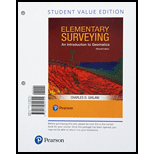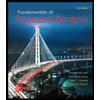
ELEMENTARY SURVEYING (LOOSELEAF)
15th Edition
ISBN: 9780134604701
Author: GHILANI
Publisher: PEARSON
expand_more
expand_more
format_list_bulleted
Concept explainers
Question
thumb_up100%
Chapter 13, Problem 13.1P
To determine
What does the GNSS receiver provide the user?
Expert Solution & Answer
Answer to Problem 13.1P
GNSS is termed as Global Navigation Satellite System. GNSS receiver determines the user position, velocity, and precise time by processing the signals broadcasted by satellite.
Explanation of Solution
GNSS receiver processes the signal in the space transmitted by the satellite. Even though information provided by this receiver can be used in a wide range of applications. GNSS receiver provides the information of position, velocity and time. Therefore, it is also known as PVT.
Initially, GNSS is only used in the military. But with the free availability of GNSS signals and cheap availability of GNSS receivers, it is now widely used in civil, industrial, scientific, and military areas.
Want to see more full solutions like this?
Subscribe now to access step-by-step solutions to millions of textbook problems written by subject matter experts!
Students have asked these similar questions
Question 6
The following figure shows peak-hour volumes for an intersection. Using Webster's method, determine
a suitable signal timing for the intersection using the four-phase system shown below. Use an amber
interval of 3 seconds and the saturation flow given in the table.
O
100
O
Phase
Lime Group
Saturation Flow
A
e
1615->
370
3700
B
1615
1615
3700
1615
3700
PHF-0.91
Pedestrian volume is negligible.
Question 7
A parking area with 60 bays has an initial count of 35 vehicles. The in-out survey data for 10-minute
intervals is as per the table below. Complete the table, calculate the accumulation, occupancy (%), and
parking load (veh.hrs) for each interval.
Time (min)
In
Out
Accumulation
Occupancy
Parking load
(%)
0
3
10
2
4
20
1
1
30
1
3
40
1
6
50
1
4
60
Q3/ The following data represent the water depth in the soil of equal areas for
specified field. Calculate the uniformity coefficient, efficiency and adequacy of
irrigation. Net needed irrigation depth =75 mm
(78-04, 79, 88, 85.21, 76,82)
Chapter 13 Solutions
ELEMENTARY SURVEYING (LOOSELEAF)
Ch. 13 - Prob. 13.1PCh. 13 - Prob. 13.2PCh. 13 - Prob. 13.3PCh. 13 - Prob. 13.4PCh. 13 - Prob. 13.5PCh. 13 - Prob. 13.6PCh. 13 - Prob. 13.7PCh. 13 - Prob. 13.8PCh. 13 - Prob. 13.9PCh. 13 - Prob. 13.10P
Ch. 13 - Prob. 13.11PCh. 13 - Prob. 13.12PCh. 13 - Prob. 13.13PCh. 13 - Prob. 13.14PCh. 13 - Prob. 13.15PCh. 13 - Prob. 13.16PCh. 13 - Prob. 13.17PCh. 13 - Prob. 13.18PCh. 13 - Prob. 13.19PCh. 13 - Prob. 13.20PCh. 13 - Prob. 13.21PCh. 13 - Prob. 13.22PCh. 13 - Prob. 13.23PCh. 13 - Prob. 13.24PCh. 13 - Prob. 13.25PCh. 13 - Prob. 13.26PCh. 13 - Prob. 13.27PCh. 13 - Prob. 13.28PCh. 13 - Prob. 13.29PCh. 13 - Prob. 13.30PCh. 13 - Prob. 13.31PCh. 13 - Prob. 13.32PCh. 13 - Prob. 13.33PCh. 13 - Prob. 13.34P
Knowledge Booster
Learn more about
Need a deep-dive on the concept behind this application? Look no further. Learn more about this topic, civil-engineering and related others by exploring similar questions and additional content below.Similar questions
- A (A) Q1/ It is required to apply a net depth of 120mm to a total area of 60 ha. The applied discharge is continuously 180 L/s. What must be the time of irrigation? Assume the application efficiency 85%. а Eas 85 0% tarrow_forwardThe following figure is a flexible pavement system with the resilient moduli layer coefficients and drainage coefficients as shown. If the predicted ESAL = 6x106, Reliability, R = 99%, Standard Deviation (So) = 0.45, and APSI = 2.5, select thicknesses D1, D2, and D3 in accordance with the AASHTO Guide for Design of Pavement Structures. E₁ = 400, 000 psi; a₁ = 0.42, Thickness = D₁ E₂=30,000 psi; a₂= 0.14, m₂ = 1.2; Thickness = Dz E=11,000 psi; a=0.08, m3 = 1.2; Thickness = D3 MR= 5,700 psiarrow_forwardDiagramtically show the placement, size, and spacing of temperature steels, dowel bars and tie bars in rigid pavements. Also mention their puproses in rigid pavements.arrow_forward
- A six-lane concrete roadway is being designed for a metropolitan area. This roadway will be constructed on a subgrade with an effective modulus of subgrade reaction k of 200 lb/in^3. The ESALs used for the design period is 6.0×10^6. Using the AASHTO design method, determine a suitable thickness of the concrete pavement (to the nearest 1/2 inch), provided that the working stress of the concrete to be used is 600 lb/in^2 and the modulus of elasticity is 6×10^6 lb/in^2. Assume the initial serviceability is 5.0 and the terminal serviceability is 2.0. Assume the overall standard deviation, So, is 0.35, the load transfer coefficient J as 3.2, the drainage coefficient, Cd, is 1.15, and R = 99%.arrow_forwardA 12-in. full-depth asphalt pavement is placed on a subgrade with aneffective roadbed resilient modulus of 7,000 psi. Assuming a layer coefficient of 0.44 for the hot mix asphalt, a drop in PSI from 4.5 to 2.5, an overall standard deviation of 0.49, and a predicted ESAL of 10 X 10^6, determine the reliability of thedesign by using the AASHTO equation and check the result by using the AASHTO design chartarrow_forwardGiven the monthly resilient modulus below, find out relative damage of each month, the average relative damage and the effective roadbed resilient modulus.Month Resilient Modulus (psi):Jan 20,000Feb 22,000March 5,000April 6,000May 7,000June 8,000July 8,500August 9,500September 9,000October 8,000November 7,000December 18,000arrow_forward
- Determine the largest torque T that can be applied to each of the twoaluminium bars shown in Figure 5 below, and the corresponding angle of twistat B, knowing that allow = 50 MPa and G = 26 GPa. [10]Figure 5 : Aluminium Bars(Source: Mechanics of Materials Beer, Johnston, DeWolf & Mazurek 6Ed p204)arrow_forwardAssume a car park facility where the arrival rate is λ customer every minute, and the service process including pressing the button, taking the card, and waiting for the boom to rise leads to service rate of μ customer every minute. a. Assume the arrival and service processes are stochastic. Using any software (Excel, Matlab, or the one you prefer), plot average delay time (including service time) and average queue size (including the vehicle currently being served) for all combinations of λ = {1,2,3,..,10} and p = {0.1,0.3,0.5,0.7,0.9}. Specifically, we ask you to make 2 graphs (one for average delay and the other for average queue size), where the x-axes contains the different values for 1, and where you make one curve for each p. b. Assume the arrival process is stochastic but the service process is deterministic with rate µ. Using any software (Excel, Matlab, or the one you prefer), plot average delay time (including service time) and average queue size (including the vehicle…arrow_forwardConsider, M people (aka pax) who want to travel by car from O to D. They all start working at D at Q (e.g., Q-8am). If a person departs at time t, assume the time needed to go from O to D is given by c(t)=A+Bx(t), where x(t) is the flow of people departing at time t [car/unit of time]. In addition, a is the penalty for being early at work (E(t) is how early the person arrived when departing at time t), and ẞ is the penalty for being late at work (L(t) is how late the person arrived when departing at time t). Assume 0 < a < 1 < ß. Further assume the departure time choice problem under the equilibrium conditions. Prove that the arrival time of people who depart when most of the M people start their trips is equal to Q.arrow_forward
- Consider, M people (aka pax) who want to travel by car from O to D. They all start working at D at Q (e.g., Q=8am). If a person departs at time t, assume the time needed to go from O to D is given by c(t)=A+Bx(t), where x(t) is the flow of people departing at time t [car/unit of time]. In addition, a is the penalty for being early at work (E(t) is how early the person arrived when departing at time t), and ẞ is the penalty for being late at work (L(t) is how late the person arrived when departing at time t). Assume 0 < a < 1 < ß. Further assume the departure time choice problem under the equilibrium conditions. Prove that the arrival time of people who depart when most of the M people start their trips is equal to Q.arrow_forward1. Plot the SWRC (suction vs. volumetric water content) from the van Genuchten (1980) model for the following “base-case” parameters (assume m = 1-1/nvG): alpha vG = 0.35 kPa-1, nvG = 2.2,Delta res = 0.02, and delta S = delta sat = 0.45. These values are approximately representative of a sand.Perform a sensitivity analysis on each of the base case parameters (i.e., vary each by ±10% while holding the other three constant) to determine their relative effects on the SWRC. For example, how would a change in s alter the curve if the other base case parameters stay the same? In your answer, provide 4 plots for the parametric evaluation of each parameter as well as a brief qualitative explanation for each plot (for example, when investigating the effect of alpha vG, show the base-case curve and the curves with different values of alpha vG on the same plot). Be sure that suction is plotted on a logarithmic scale. Also, discuss how theparameters of the van Genuchten SWRC model might differ…arrow_forwardUsing AutoCAD and exact measure that numberarrow_forward
arrow_back_ios
SEE MORE QUESTIONS
arrow_forward_ios
Recommended textbooks for you

 Structural Analysis (10th Edition)Civil EngineeringISBN:9780134610672Author:Russell C. HibbelerPublisher:PEARSON
Structural Analysis (10th Edition)Civil EngineeringISBN:9780134610672Author:Russell C. HibbelerPublisher:PEARSON Principles of Foundation Engineering (MindTap Cou...Civil EngineeringISBN:9781337705028Author:Braja M. Das, Nagaratnam SivakuganPublisher:Cengage Learning
Principles of Foundation Engineering (MindTap Cou...Civil EngineeringISBN:9781337705028Author:Braja M. Das, Nagaratnam SivakuganPublisher:Cengage Learning Fundamentals of Structural AnalysisCivil EngineeringISBN:9780073398006Author:Kenneth M. Leet Emeritus, Chia-Ming Uang, Joel LanningPublisher:McGraw-Hill Education
Fundamentals of Structural AnalysisCivil EngineeringISBN:9780073398006Author:Kenneth M. Leet Emeritus, Chia-Ming Uang, Joel LanningPublisher:McGraw-Hill Education
 Traffic and Highway EngineeringCivil EngineeringISBN:9781305156241Author:Garber, Nicholas J.Publisher:Cengage Learning
Traffic and Highway EngineeringCivil EngineeringISBN:9781305156241Author:Garber, Nicholas J.Publisher:Cengage Learning


Structural Analysis (10th Edition)
Civil Engineering
ISBN:9780134610672
Author:Russell C. Hibbeler
Publisher:PEARSON

Principles of Foundation Engineering (MindTap Cou...
Civil Engineering
ISBN:9781337705028
Author:Braja M. Das, Nagaratnam Sivakugan
Publisher:Cengage Learning

Fundamentals of Structural Analysis
Civil Engineering
ISBN:9780073398006
Author:Kenneth M. Leet Emeritus, Chia-Ming Uang, Joel Lanning
Publisher:McGraw-Hill Education


Traffic and Highway Engineering
Civil Engineering
ISBN:9781305156241
Author:Garber, Nicholas J.
Publisher:Cengage Learning